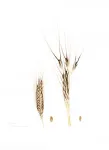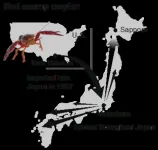(Press-News.org) Building on the Middle East’s reputation as one of the historical birthplaces of cereal crop domestication, a KAUST-led team has compiled the first complete genome map of an ancient grain known as einkorn[1].
The 5.2-billion-letter-long sequence provides a window into the evolutionary origins of different wheat species. It could help farmers and crop breeders to develop bread wheat varieties with enhanced disease resistance, higher yields and improved hardiness.
“By understanding the genetic diversity and evolutionary history of einkorn, researchers can now leverage its potential for future breeding efforts and the development of more resilient and nutritious wheat varieties,” says Hanin Ahmed, one of the study’s first authors, and a former Ph.D. student at KAUST.
Einkorn is one of the world’s oldest domesticated grains, dating back more than 10,000 years to the fertile regions of the Middle East, where its cultivation began. Known as Triticum monococcum, einkorn is still consumed today, cherished for its unique flavor profile and numerous nutritional benefits. However, its significance in global food production over the millennia has gradually declined as the popularity of bread wheat soared.
Bread wheat varieties generally produce higher yields, making them more economically viable for large-scale commercial agriculture. Yet, compared to its wild cousins, modern bread wheat has a reduced genetic diversity — and many breeders are now concerned about how existing crops will fare in the face of climate change and new disease threats.
Enter einkorn. Because the ancient grain has maintained a larger gene pool, it could hold the genetic secrets needed to develop bread wheat that can continue to feed the world’s growing population.
To unlock those secrets, a team led by Simon Krattinger and Jesse Poland from KAUST, deployed a combination of DNA sequencing technologies to create high-quality genome assemblies for wild and domesticated einkorn varieties alike.
Researchers had previously assumed that the evolution of wheat was a steady process with limited mixing of different wheat species. But, according to Krattinger: “Our genomic analyses now show that the history of wheat is much more complex and involved a lot of mixing and gene flow between different wheat species,” including einkorn, which likely grew in close proximity to other wheat varieties, leading to DNA mixing between the two closely related species that remains evident to this day.
Just as the human genome contains sequences from our Neanderthal cousins, so too is the modern bread wheat genome littered with remnants of einkorn DNA.
Indeed, the introduction of einkorn genes in the past may have played a role in assisting bread wheat to adapt to changing climatic conditions, Krattinger notes. And if history is any indication, the same could hold true for the future, especially with the aid of modern molecularly guided breeding techniques.
“Our lab’s resources will help to precisely transfer beneficial genes from einkorn into bread wheat,” Krattinger says.
END
An ancient grain unlocks genetic secrets for making bread wheat more resilient
2023-08-02
ELSE PRESS RELEASES FROM THIS DATE:
Perinatal depression screening among sexual minority women
2023-08-02
About The Study: The findings of this study suggest that, although sexual minority women are at high risk of postpartum depression, their sexual identities are largely undocumented in medical records, highlighting the need for strategies to measure sexual orientation that can reliably capture this information.
Authors: Leiszle Lapping-Carr, Ph.D., of the Northwestern University Feinberg School of Medicine in Chicago, is the corresponding author.
To access the embargoed study: Visit our For The Media website at ...
Comparative risks of potential adverse events following COVID-19 mRNA vaccination among older adults
2023-08-02
About The Study: In this study of 6.3 million older U.S. adults, the mRNA-1273 (Moderna) vaccine was associated with a slightly lower risk of several adverse events compared with BNT162b2 (Pfizer-BioNTech), possibly due to greater protection against COVID-19. Future research should seek to formally disentangle differences in vaccine safety and effectiveness and consider the role of frailty in assessments of COVID-19 vaccine performance.
Authors: Daniel A. Harris, Ph.D., of the Brown University School of Public Health in Providence, Rhode Island, is the corresponding ...
Moderna is safest, most effective mRNA vaccine against COVID-19 for older adults, study shows
2023-08-02
PROVIDENCE, R.I. [Brown University] — While mRNA vaccines against COVID-19 have been found to be safe and effective for the general population, in-depth evidence about safety and effectiveness for older adults and individuals with chronic health conditions is more limited.
To address that gap, a team led by Brown University researchers conducted the largest head-to-head comparison study of the two mRNA vaccines approved by the U.S. Food and Drug Administration — the Moderna and Pfizer-BioNTech vaccines. The results, published in JAMA Network Open, ...
Fiber optic cables detect and characterize earthquakes
2023-08-02
In California, thousands of miles of fiber optic cables crisscross the state, providing people with internet. But these underground cables can also have a surprising secondary function: they can sense and measure earthquakes. In a new study at Caltech, scientists report using a section of fiber optic cable to measure intricate details of a magnitude 6 earthquake, pinpointing the time and location of four individual asperities, the "stuck" areas of the fault, that led to the rupture.
For several years, Professor of Geophysics Zhongwen Zhan (PhD '14) ...
Potential neuropathic pain treatment shows promise in preclinical tests
2023-08-02
A non-opioid designer molecule for treating chronic neuropathic pain by calming hyperactive pain-sensing neurons in the peripheral nervous system has had promising results in a preclinical study conducted by researchers at Weill Cornell Medicine and the Burke Neurological Institute.
In the study, published Aug. 2 in the British Journal of Anaesthesia, the first-in-class drug conceptualized by lead author Dr. Gareth Tibbs was found to function according to its design at both the molecular level and as an apparently side-effect-free pain reliever in rats.
“With either a single dose or seven days of daily dosing, we saw a significant reversal of neuropathic pain signs in the ...
Learning how to control HIV from African genomes
2023-08-02
“We searched for human genetic variation that associates with spontaneous control of HIV and identified a novel region in the genome that is only variable in populations of African ancestries,” says Professor Jacques Fellay at EPFL’s School of Life Sciences. “We used a combination of computational and experimental approaches to explore the biological mechanism behind the genetic association and provide evidence that the gene CHD1L acts to limit HIV replication in a subset of white blood cells.”
HIV is still a problem
Despite significant advances in treatment and access to therapy, the ...
How the tropical red swamp crayfish successfully invaded the cold regions of Japan
2023-08-02
Owing to human activities and climate change, many animal species have invaded new habitats. Such biological invasion comes with devastating impacts on the local biodiversity and ecosystems. The red swamp crayfish—known to the scientific world as Procambarus clarkii (P. clarkii)— is no exception. P. clarkii is a freshwater crayfish native to the tropical regions of southern USA and northeastern Mexico. After their introduction to different parts of the world, they have become one of the most widespread and invasive animal species. They are known for their adaptability and aggressive behavior that ensure their survival in a wide range of environments, ...
Breast cancer patients with higher BMI more likely to experience heart damage during chemotherapy
2023-08-02
Breast cancer survival rates have improved considerably in the last few decades in Colombia, but factors that increase the likelihood of patients experiencing cardiovascular side effects, like cardiotoxicity, are not well-known or well-treated. A recent study in the North-East region of Colombia found 11.94% of patients with a high BMI being treated for breast cancer at a regional center experienced heart damage, or cardiotoxicity, during chemotherapy. The study will be presented at the American College of Cardiology (ACC) Latin America 2023 Together with Asociación Costarricense ...
Study presents workaround for randomized experiments
2023-08-02
AUSTIN, Texas – A new statistical tool can help researchers get meaningful results when a randomized experiment, considered the gold standard, is not possible.
Randomized experiments split participants into groups by chance, with one undergoing an intervention and the other not. But in real-world situations, they can’t always be done. Companies might not want to use the method, or such experiments might be against the law.
Developed by a researcher at The University of Texas at Austin, the new tool called two-step synthetic control adapts an existing research workaround, known as the synthetic control method.
The ...
Cal Poly study analyzes nearshore California marine heatwaves and cold spells amid changing climate conditions
2023-08-02
The first-ever study to look at drivers of both marine heatwaves and cold spells in the shallow nearshore along the California Current —coordinated by California Polytechnic State University, San Luis Obispo (Cal Poly) and the Virginia Institute of Marine Science, William & Mary — found that certain environmental conditions and the state of the ocean can lead to an enhanced risk for ocean temperature extremes.
The findings were recently published in Nature Scientific Reports in an article titled “Effects of basin-scale climate modes and upwelling on nearshore marine heatwaves and cold spells in the California Current.”
Extreme ...




